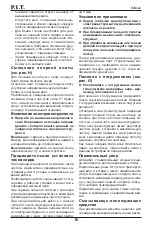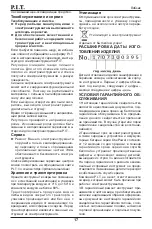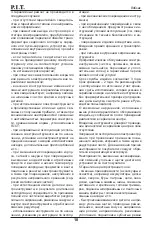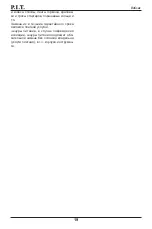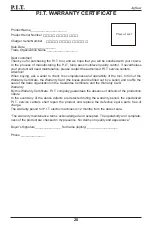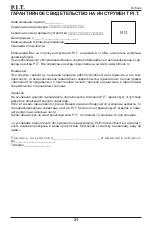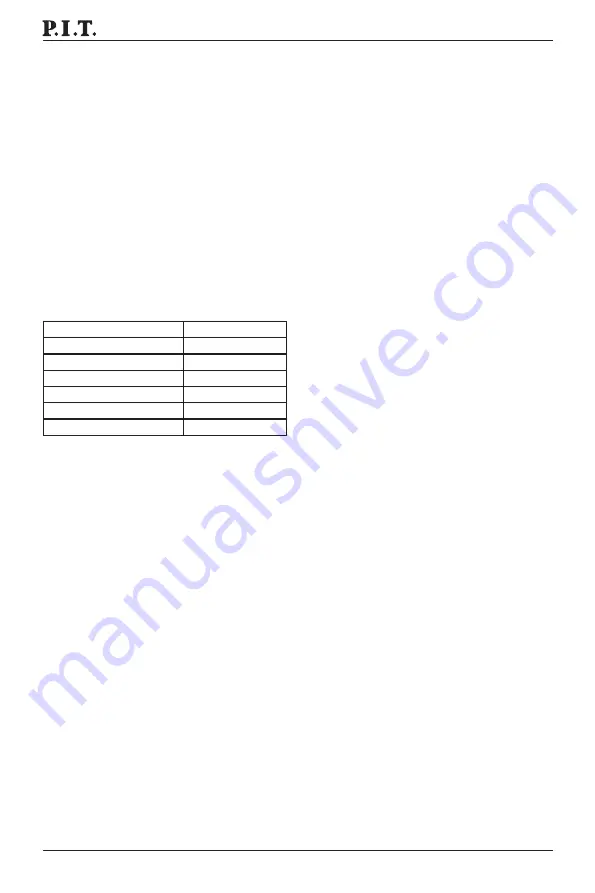
Jig Saw
6
(2) Stroke rate preselection thumbwheel
(3) Hex key
(4) Base plate
(5) Pendulum action adjusting lever
(6) SDS lever for saw blade release
(7) Guide roller
(8) Saw blade
(9) Shock protection guard
(10) Handle (insulated gripping surface)
(11) Saw blade receptacle
(12) Protective pad
(13) Safety glass
(14) Extraction outlet
(15) Vacuum cleaner adapter
(16) Base plate screw
(17) Scale for mitre/bevel angles
(18) Guide for parallel guide
(19) Locking screw for parallel guide
Technical parameter
Model
PST110-C
Rated voltage
220 V~/50 Hz
Rated power
750 W
Reciprocating frequency
1000-3100 spm
Wood cutting depth
110 mm(4-11/32")
Metal cutting depth
26 mm(1")
Weight
3.4 kg
Contents of delivery
Jig Saw
1 pc
Woodworking saw blade
1 pc
Metal saw blade
1 pc
Guide rule fi xed knob
2 pcs
Parallel stop
1 pc
Dust extraction pipe
1 pc
Allen wrench
1 pc
Instruction manual
1 pc
Note
Since the product is constantly being im-
proved,
P.I.T.
reserves the right to make
changes to the specifications and product
specifi cations specifi ed here without prior no-
tice.
Assembly
► Pull the plug out of the socket before
carrying out any work on the power
tool.
Inserting/changing the saw blade
► When fi tting or changing the saw blade,
wear protective gloves.
Blades are sharp
and can become hot when used for pro-
longed periods of time.
Selecting the saw blade
Only use saw blades with single lug shank (T
shank). The saw blade should not be longer
than required for the intended cut.
Use a narrow saw blade when sawing tight
curves.
Inserting the saw blade (see fig-
ure A)
► Clean the shaft on the saw blade before
inserting it.
A dirty shaft cannot be secure-
ly fi xed in place.
Press the SDS lever forward to the stop and
hold it down. Push the saw blade, with the
teeth in the cutting direction, into the saw
blade receptacle until it clicks into place.
Make sure when inserting the saw blade that
the back of the saw blade is in the groove on
the guide roller.
► Check that the saw blade is seated se-
curely.
A loose saw blade can fall out and
lead to injuries.
Ejecting the saw blade (see fi gure
B)
► When ejecting the saw blade, hold the
power tool in such a manner that no
persons or animals can be in jured by
the ejected saw blade.
Press the SDS lever forward to the stop. The
saw blade is released and ejected.
Protective pad (see fi gure C)
When machining sensitive surfaces, you can
place the protective pad on the base plate
in order to prevent the surface from being
scratched.
To position the protective pad, hook it to the
front of the base plate, push it up at the back
and allow it to click into place.
Dust/Chip Extraction
The dust from materials such as lead paint,
some types of wood, minerals and metal
can be harmful to human health. Touching or
breathing in this dust can trigger allergic reac-
tions and/or cause respiratory illnesses in the
user or in people in the near vicinity.
Certain dusts, such as oak or beech dust,
are classified as carcinogenic, especially in
conjunction with wood treatment additives
(chromate, wood preservative). Materials con-
taining asbestos may only be machined by
specialists.
– Use a dust extraction system that is suit-
able for the material wherever possible.
– Provide good ventilation at the workplace.
– It is advisable to wear a P2 filter class
breathing mask. The regulations on the
material being machined that apply in the
country of use must be observed.

















